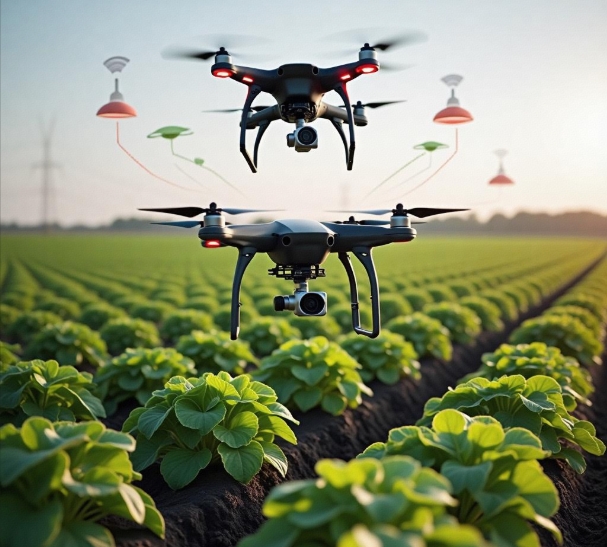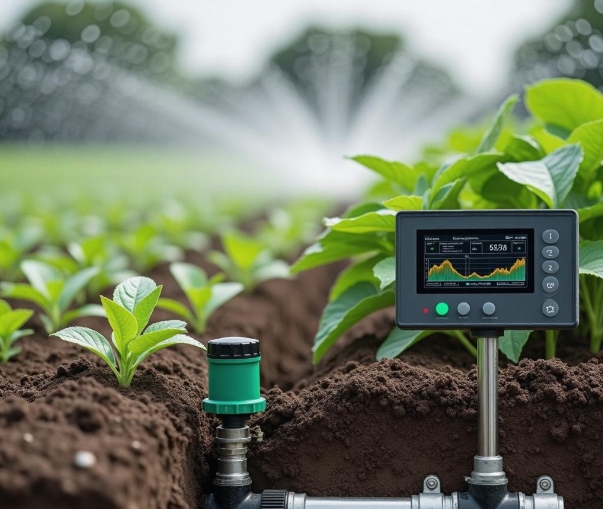Innovative Applications of IoT Development in Agricultural Intelligence
- latest articles
- 1.DApp Development & Customization: Merging Diverse Market Needs with User Experience 2.Analysis of the Core Technical System in DApp Project Development 3.How to achieve cross-chain interoperability in Web3 projects? 4.How does the tokenization of points reconstruct the e-commerce ecosystem? 5.How to Set and Track Data Metrics for a Points Mall? 6.What is DApp Development? Core Concepts and Technical Analysis 7.Inventory of commonly used Web3 development tools and usage tips 8.Development of a Distribution System Integrated with Social E-commerce 9.Six Key Steps for Businesses to Build a Points Mall System 10.What is DApp Development? A Comprehensive Guide from Concept to Implementation
- Popular Articles
- 1.Future Trends and Technology Predictions for APP Development in 2025 2.Analysis of the DeFi Ecosystem: How Developers Can Participate in Decentralized Finance Innovation 3.From Zero to One: How PI Mall Revolutionizes the Traditional E-commerce Model 4.DAPP Development | Best Practices for Professional Customization and Rapid Launch 5.How to Develop a Successful Douyin Mini Program: Technical Architecture and Best Practices 6.Recommended by the Web3 developer community: the most noteworthy forums and resources 7.From Cloud Computing to Computing Power Leasing: Building a Flexible and Scalable Computing Resource Platform 8.Shared Bike System APP: The Convenient Choice in the Era of Smart Travel 9.How to Create a Successful Dating App: From Needs Analysis to User Experience Design 10.From Design to Development: The Complete Process of Bringing an APP Idea to Life
With the rapid advancement of technology, the Internet of Things (IoT) has become a core force driving transformation across various industries. In the agricultural sector, the application of IoT technology not only enhances production efficiency but also plays a significant role in improving agricultural sustainability and optimizing resource utilization. Through intelligent devices and systems, IoT can collect and analyze environmental data in real time, helping farmers achieve precision agriculture, reduce resource waste, and simultaneously increase crop yield and quality. This article will explore the innovative applications of IoT in agricultural intelligence and analyze its profound impact on the future development of agriculture.
I. Overview of IoT Technology
The Internet of Things is a network that connects various information-sensing devices with objects via the internet, enabling interconnection between things. Specifically, IoT technology utilizes sensors, radio frequency identification (RFID), wireless communication, cloud computing, and other technologies to collect and transmit data, achieving information sharing and intelligent management. In agriculture, IoT applications are primarily focused on areas such as agricultural production, environmental monitoring, and crop management, enhancing the intelligence level of agricultural production through precise monitoring and automated control.
II. Application Areas of IoT in Agricultural Intelligence
1. Precision Agriculture
Precision agriculture is one of the most representative applications of IoT technology in the agricultural field. Traditional agricultural production methods rely on farmers' experience and intuition, which makes it difficult to make scientific decisions based on real-time data. IoT collects various environmental data from farmland, such as soil moisture, temperature, and light intensity, and combines it with advanced data analysis algorithms to provide farmers with real-time decision support. For example, based on data from soil moisture sensors, farmers can accurately understand the water conditions of their fields, avoiding unnecessary irrigation, which conserves water resources and ensures healthy crop growth.
Additionally, IoT can also monitor crops using drones and smart robots. Drones can fly to various corners of the farmland, capture high-definition images, identify signs of pests and diseases, and even perform precise spraying in affected areas. This allows farmers to take timely measures to prevent crop losses.
2. Agricultural Environmental Monitoring
The application of IoT technology in agricultural environmental monitoring is also extremely important. Agricultural production environments are influenced by various factors such as climate, soil, and air quality, and traditional monitoring methods cannot achieve comprehensive, real-time, and precise monitoring. IoT, through sensor networks, can monitor various environmental data in farmland in real time and transmit the data to cloud platforms for analysis by farmers and agricultural experts.
For example, in greenhouses, IoT devices can monitor parameters such as temperature, humidity, and CO2 concentration, automatically adjusting the operation of fans, heaters, and irrigation systems to ensure crops grow in the most suitable environment. Furthermore, IoT can monitor air quality to prevent pollutants from affecting crops, thereby ensuring the quality of agricultural products.
3. Smart Irrigation Systems
Water resources are one of the most critical resources in agricultural production; however, traditional irrigation methods often lead to water wastage. The introduction of IoT technology has enabled the implementation of smart irrigation systems. These systems use soil moisture sensors installed in farmland to monitor soil moisture conditions in real time and automatically activate the irrigation system based on preset thresholds. When soil moisture falls below the set value, the irrigation system turns on automatically, preventing over-irrigation and water waste.
For instance, some advanced smart irrigation systems not only rely on soil moisture sensors but also incorporate meteorological data, such as weather forecasts and precipitation conditions, to further optimize irrigation strategies. This precise irrigation method not only saves significant water resources but also improves crop growth efficiency and reduces production costs.
4. Smart Agricultural Machinery
IoT technology is also widely applied in the intelligent transformation of agricultural machinery. Traditional agricultural machinery mostly relies on manual operation, resulting in low efficiency and a high likelihood of operational errors. With the introduction of IoT technology, agricultural machinery can achieve automated and intelligent operations. For example, automated tractors, seeders, and harvesters can adjust their working modes based on soil conditions, crop growth status, and meteorological data, precisely executing various field tasks.
These smart agricultural machines are typically equipped with sensors and GPS navigation systems, enabling precise positioning to avoid repetitive work and missed tasks. Through remote control platforms, farmers can also monitor the working status of machinery in real time, adjust operational plans promptly, improve work efficiency, and reduce labor costs.
5. Agricultural Product Traceability and Supply Chain Management
As consumers increasingly focus on food safety and quality, the traceability and supply chain management of agricultural products have become particularly important. IoT technology enables full-process traceability from production, processing, to sales by attaching RFID tags or QR codes to each agricultural product. Consumers can scan the QR code to view the origin, production process, and transportation information of the product, thereby increasing their trust in agricultural products.
Additionally, IoT can help agricultural enterprises manage their supply chains. By monitoring inventory, transportation, sales, and other aspects of agricultural products in real time, enterprises can allocate resources more efficiently, reduce inventory backlog and waste, and enhance the transparency and efficiency of the supply chain.
III. Impact of IoT Technology on the Future Development of Agriculture
The widespread application of IoT technology is driving the intelligence and automation of agriculture, bringing many positive changes. First, IoT technology can significantly improve agricultural production efficiency. Through precise environmental monitoring, smart irrigation, and automated operations, farmers can reduce resource waste, increase crop yield and quality, and thereby enhance overall production efficiency.
Second, IoT helps promote sustainable agricultural development. By optimizing water resource usage and reducing the use of pesticides and fertilizers, IoT technology can effectively minimize the negative environmental impact of agricultural production, driving agriculture toward a greener and more environmentally friendly direction.
Third, the innovative application of IoT technology in agriculture can bring transformation to every link of the agricultural industry chain. Applications such as product traceability and supply chain optimization not only enhance the competitiveness of agricultural enterprises but also increase consumer trust in agricultural products, thereby promoting the stable development of the agricultural market.
Finally, the application of IoT in agriculture can attract more technological talent and investment into the agricultural sector, promoting the deep integration of agriculture with emerging technologies such as information technology and artificial intelligence, and opening up broader prospects for the future development of agriculture.
IV. Challenges and Future Prospects
Although IoT has shown great potential in agriculture, it still faces some challenges in practical application. First, the cost of IoT devices is relatively high, especially for small-scale farmers, making device investment a significant burden. Second, agricultural environments are complex and variable, and ensuring the stability and reliability of IoT devices remains a pressing issue. Additionally, the popularization of IoT technology requires corresponding infrastructure support, such as communication networks and power supply.
In the future, as technology continues to develop and costs gradually decrease, IoT will see broader application in agriculture. Governments, research institutions, and enterprises should increase investment in IoT technology research and development while strengthening technical training for farmers to promote the popularization and application of IoT in agriculture.
Conclusion
IoT technology provides strong technical support for agricultural intelligence, driving the transformation of agricultural production methods. Innovative applications such as precision agriculture, smart irrigation, and agricultural environmental monitoring are making agricultural production more efficient, sustainable, and intelligent. With the continuous development of IoT technology, we have reason to believe that the future of agriculture will be greener, more environmentally friendly, and smarter, making greater contributions to global food security and sustainable development.
-

How to Use IoT Development to Enhance Supply Chain Efficiency
With the rapid development of the global economy and the deepening of digital tr···
-

Development and Innovation of the Internet of Things in the Healthcare Sector
With the rapid advancement of information technology, the Internet of Things (Io···
-

Data Storage and Analysis Methods in IoT Development
The Internet of Things (IoT) is one of the most revolutionary innovations in tod···

 Blockchain
Blockchain












